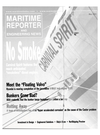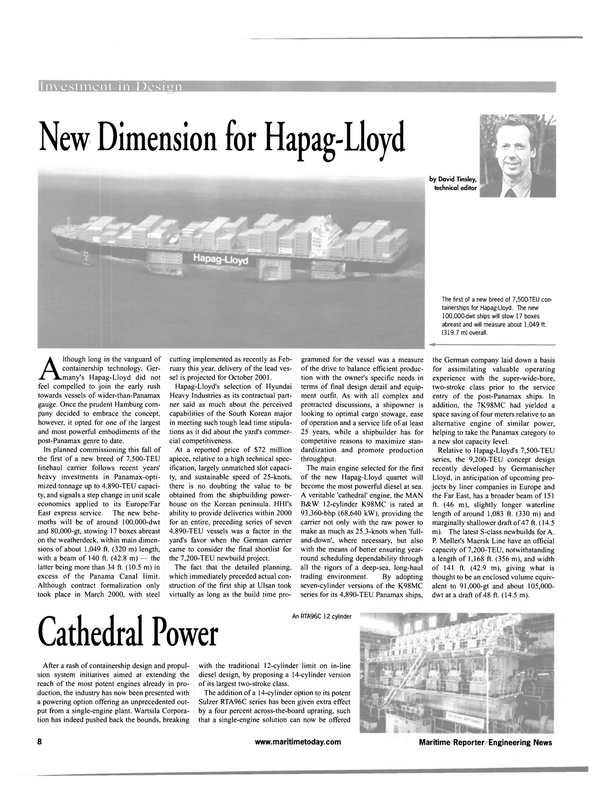
Cathedral Power
After a rash of containership design and propulsion system initiatives aimed at extending the reach of the most potent engines already in production, the industry has now been presented with a powering option offering an unprecedented output from a single-engine plant. Wartsila Corporation has indeed pushed back the bounds, breaking with the traditional 12-cylinder limit on in-line diesel design, by proposing a 14-cylinder version of its largest two-stroke class.
The addition of a 14-cylinder option to its potent Sulzer RTA96C series has been given extra effect by a four percent across-the-board uprating, such that a single-engine solution can now be offered for power requirements up to a stunning 108,920-bhp (80,080-kW). The 19,280- bhp (14,200-kW) step-up in maximum unit output secured by the uprating in combination with the inclusion of a 14- cylinder model offers a 25-knot, singleengine, single-screw answer for vessels of up to 10,000-TEU. It also enables faster speeds to be engendered in existing sizes of post-Panamax container carrier, assuming that the space and weight penalties can be offset by the speed gains.
After all, increased power of the magnitude offered will necessarily mean higher engine weight and increased engine room length. Furthermore, there may be something of a psychological barrier to be crossed by shipping company engineers in adopting a 14-cylinder format of crosshead engine. But radical engineering steps are needed to secure the advances in linehaul vessel capacity demanded by shipping economics.
The industry's clear preference for single, diesel prime mover installations gives a pragmatic commercial basis to the Wartsila move, complementing the technical case. In fact, rival MAN B&W has conceptualized 13- to 18-cylinder in-line versions of its large-bore K98 engines, which could potentially cover the needs of a future generation of 25- knot vessels with stow capacities up to 18,000-TEU.
Experts believe that ship sizes between 10,000- and 12,000-TEU can be anticipated in future, although practical considerations seem to preclude an advance in the medium-term to drafts greater than 50 ft. (15.3 m).
As it stands, nowhere in Europe has the production capability for the 14- cylinder Sulzer engine proposed by Wartsila. The Finnish power system supplier's largest factory, the former Grandi Motori Trieste plant in Italy, can build diesels up to the 8RTA84C size, of some 44,000-bhp. The RTA96C accordingly falls exclusively within the province of Far Eastern licensees.
Hyundai, the world's most prolific marine diesel engine manufacturer, has recently taken a global lead by readying its global works to fabricate and test two-stroke engines in excess of 100,000-bhp.
Read Cathedral Power in Pdf, Flash or Html5 edition of May 2001 Maritime Reporter
Other stories from May 2001 issue
Content
- EU Subsidy Program To Be Considered page: 4
- Nichols Brothers Delivers 39-knot Catamaran page: 4
- New Dimension for Hapag-Lloyd page: 8
- Cathedral Power page: 8
- "The Floating Volvo" HHI Builds Twin Engine V-Max VLCC page: 12
- EAR Takes Lead In RoPax Market page: 14
- N e w ATB Joint Venture Is Formed page: 16
- Unauthorized W e l d i n g Caused Carnival Ecstasy Fire page: 17
- Castor's Downfall: Hyper-Accelerated Corrosion page: 18
- N N S 1Q EPS Up 19% page: 27
- N a v y Honors Propeller Expert page: 28
- L-3 Communications Delivers Premiere Production HVR page: 29
- New "Ax-Bow" To Increase Ships' Efficiency page: 30
- R o - C l e a n D e s m i Sets W o r ld R e c o r d For L a r g e s t O il C o n t a i n m e n t B o om page: 31
- Reintjes IPP System Rewarded W i t h Orders page: 32
- Online Design, Drafting Offered page: 32
- Large Passenger Vessels Benefit From Norsafe's Rescube page: 33
- Ensolve Develops Innovative Oily Water Separator page: 34
- Titan Innovation Replaces Sheerleg Crane page: 35
- NavCad V 4 . 0 Released page: 35
- The Tribon Ml Developer's Toolkit page: 36
- Autoship Systems Software: Ruling The Waves page: 36
- Yachting Consult Offers MasterShip page: 37
- Barging Ahead page: 38
- Size Matters page: 42
- ISU Survey Points Out Bunker Concerns page: 43
- Carnivals New Spirit page: 44
- Meet Me In Oslo page: 48
- Norway's Caretaker Protects Precious Cargo page: 50
- 2 0 0 0 A Good Year for MaK page: 57
- AMCV Christens Premiere Vessel In Delta Queen Fleet page: 60


